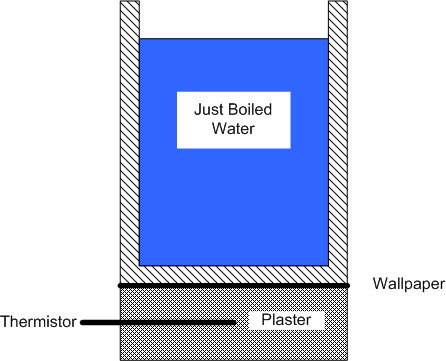The starting point for the investigation was the plaster cast of a short length of toilet roll. The idea was to create a section of wall, albeit without the supporting brickwork. Embedded in the plaster was thermistor which allowed the internal temperature of the wall to be measured.
The idea was to place a sample of wallpaper between a heat source and the section of plaster and measure the temperature rise with the thermistor. After some messing with kitchen utensils, the selected heat source was a flat bottomed coffee mug of just boiled water. This is a diagram of the apparatus:
The implementation was not as neat as the diagram and for that reason no photo has been included. This setup was not going to capable of providing the data to estimate thermal conductivity (e.g. U values), but it was able to indicate the relative insulating effects of various wallcoverings. The methodology was to place a mug of freshly boiled water on top of the wallpaper and take measurements of the thermistor's resistance at one minute intervals. These were then turned into a warming curve, the lower the temperature rise, the greater the insulating effect of the wallcovering. The results are shown in the graph below:
The base case is just the plaster surface, a layer of lining paper had some moderate insulating effect, but a sample of thick wallpaper clearly reduced the flow of heat into the plaster. Neither was a effective as a 2 mm layer of polystyrene. So it might be reasonable to assume that wallpaper was an element in the house's energy economy.
As a schoolboy, I remember being taken/dragged around some stately piles whose walls were lined with portraits of dignified people, which I now realise may have have been quite degenerate (I'm not jealous). In such places, the smaller rooms were hung with tapestries or lined with fabric to keep the place cosy, so heavy wall paper is just the mass market descendant of the tapestry.
Victorian and Edwardian houses were designed to be porous (i.e. drafty). I'm not fully certain of the mechanism, but sealing/insulating walls can become a source of damp which degrades the bond between the top and base coats of plaster or the supporting brickwork.
As a schoolboy, I remember being taken/dragged around some stately piles whose walls were lined with portraits of dignified people, which I now realise may have have been quite degenerate (I'm not jealous). In such places, the smaller rooms were hung with tapestries or lined with fabric to keep the place cosy, so heavy wall paper is just the mass market descendant of the tapestry.
Victorian and Edwardian houses were designed to be porous (i.e. drafty). I'm not fully certain of the mechanism, but sealing/insulating walls can become a source of damp which degrades the bond between the top and base coats of plaster or the supporting brickwork.





No comments:
Post a Comment